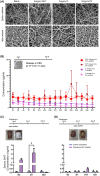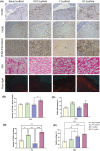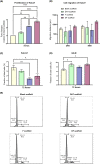Controlled dual release of dihydrotestosterone and flutamide from polycaprolactone electrospun scaffolds accelerate burn wound healing
- PMID: 35394674
- PMCID: PMC9540550
- DOI: 10.1096/fj.202101803R
Controlled dual release of dihydrotestosterone and flutamide from polycaprolactone electrospun scaffolds accelerate burn wound healing
Abstract
Wound healing is a complex process involving multiple independent and overlapping sequential physiological mechanisms. In addition to cutaneous injury, a severe burn stimulates physiological derangements that induce a systemic hypermetabolic response resulting in impaired wound healing. Topical application of the anti-androgen drug, flutamide accelerates cutaneous wound healing, whereas paradoxically systemic dihydrotestosterone (DHT) improves burn wound healing. We developed and characterized a PCL scaffold that is capable of controlled release of androgen (DHT) and anti-androgen (F) individually or together. This study aims to investigate whether local modification of androgen actions has an impact on burn injury wound healing. In a full-thickness burn wound healing, mouse model, DHT/F-scaffold showed a significantly faster wound healing compared with F-scaffold or DHT-scaffold. Histology analysis confirmed that DHT/F-scaffold exhibited higher re-epithelization, cell proliferation, angiogenesis, and collagen deposition. Dual release of DHT and F from PCL scaffolds promoted cell proliferation of human keratinocytes and alters the keratinocyte cell cycle. Lastly, no adverse effects on androgen-dependent organs, spleen and liver were observed. In conclusion, we demonstrated DHT plus F load PCL scaffolds accelerated burn wound healing when loading alone did not. These findings point to a complex role of androgens in burn wound healing and open novel therapeutic avenues for treating severe burn patients.
Keywords: PCL scaffold; androgens; burn injury; controlled drug delivery; flutamine; wound healing.
© 2022 The Authors. The FASEB Journal published by Wiley Periodicals LLC on behalf of Federation of American Societies for Experimental Biology.
Figures






Similar articles
-
[Application effect of a dual release system of androgen and its antagonist in the repair of full-thickness burn wounds in mice].Zhonghua Shao Shang Yu Chuang Mian Xiu Fu Za Zhi. 2024 Feb 20;40(2):180-189. doi: 10.3760/cma.j.cn501225-20230802-00033. Zhonghua Shao Shang Yu Chuang Mian Xiu Fu Za Zhi. 2024. PMID: 38418180 Free PMC article. Chinese.
-
Dihydrotestosterone (DHT) Enhances Wound Healing of Major Burn Injury by Accelerating Resolution of Inflammation in Mice.Int J Mol Sci. 2020 Aug 28;21(17):6231. doi: 10.3390/ijms21176231. Int J Mol Sci. 2020. PMID: 32872240 Free PMC article.
-
Androgen actions in mouse wound healing: Minimal in vivo effects of local antiandrogen delivery.Wound Repair Regen. 2016 May;24(3):478-88. doi: 10.1111/wrr.12420. Epub 2016 May 6. Wound Repair Regen. 2016. PMID: 26873751
-
The contradictory role of androgens in cutaneous and major burn wound healing.Burns Trauma. 2021 Apr 20;9:tkaa046. doi: 10.1093/burnst/tkaa046. eCollection 2021 Jan. Burns Trauma. 2021. PMID: 33928173 Free PMC article. Review.
-
An update on stem cells applications in burn wound healing.Tissue Cell. 2021 Oct;72:101527. doi: 10.1016/j.tice.2021.101527. Epub 2021 Mar 16. Tissue Cell. 2021. PMID: 33756272 Review.
Cited by
-
Assessing the Biocompatibility and Regeneration of Electrospun-Nanofiber Composite Tracheal Grafts.Laryngoscope. 2024 Mar;134(3):1155-1162. doi: 10.1002/lary.30955. Epub 2023 Aug 14. Laryngoscope. 2024. PMID: 37578209 Free PMC article.
-
Gut microbiome and inflammation in cardiovascular drug response: trends in therapeutic success and commercial focus.Inflammopharmacology. 2025 Jan;33(1):49-68. doi: 10.1007/s10787-024-01593-x. Epub 2024 Nov 2. Inflammopharmacology. 2025. PMID: 39488611 Review.
-
[Application effect of a dual release system of androgen and its antagonist in the repair of full-thickness burn wounds in mice].Zhonghua Shao Shang Yu Chuang Mian Xiu Fu Za Zhi. 2024 Feb 20;40(2):180-189. doi: 10.3760/cma.j.cn501225-20230802-00033. Zhonghua Shao Shang Yu Chuang Mian Xiu Fu Za Zhi. 2024. PMID: 38418180 Free PMC article. Chinese.
-
Unlocking the role of wound microbiome in diabetic, burn, and germ-free wound repair treated by natural and synthetic scaffolds.Acta Pharm Sin B. 2025 Jan;15(1):611-626. doi: 10.1016/j.apsb.2024.08.024. Epub 2024 Sep 1. Acta Pharm Sin B. 2025. PMID: 40041888 Free PMC article.
References
-
- Ahn CS, Maitz PK. The true cost of burn. Burns. 2012;38:967‐974. - PubMed
Publication types
MeSH terms
Substances
LinkOut - more resources
Full Text Sources
Medical

